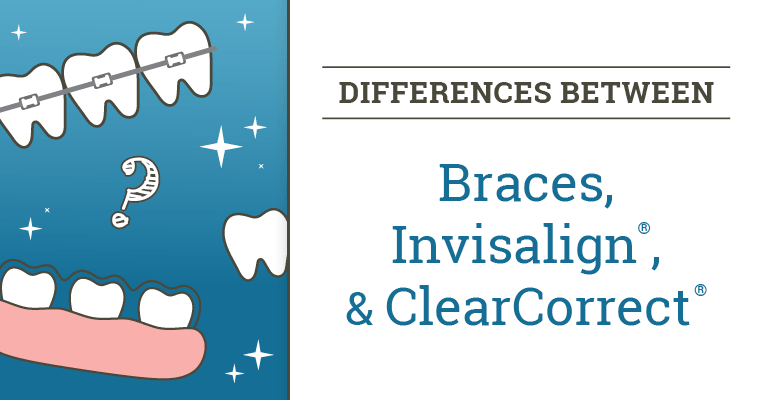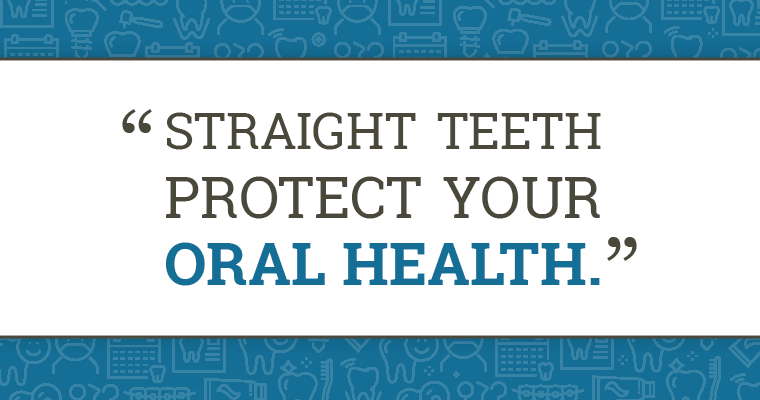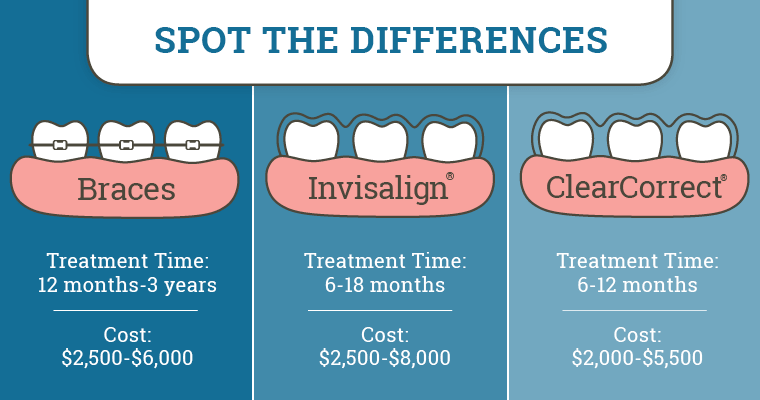The Differences Between Our Orthodontic Options: Braces, Invisalign®, & ClearCorrect®

It wasn’t so long ago when the only way to have straight teeth was using metal braces and brackets. Today, there is a variety of orthodontic options available.
At Carol Stream & Elgin Dental Associates, we offer three fabulous orthodontic services; braces, Invisalign®, and ClearCorrect®.
What are the differences between these orthodontic options? Is one better than the others? Which one should you use?
We’ve brought together all the vital information you need, so you can make the right decision for your treatment!
Why a straight smile is important
Everyone wants a straight smile.
Why?
It looks beautiful and healthy.
A recent studyNew page opens in Pr Newswire website confirmed people with straight teeth are perceived as smarter, more successful, and attractive.
Orthodontic treatment can help fix common cosmetic issues most people feel unhappy about with their smiles, such as:
- Crooked teeth
- Gapped teeth
- Crowded teeth
- Overbite, underbite, crossbite
However, aesthetics are not the only reason why a straight smile is so important. Having properly aligned teeth is also essential for your smile’s health.
Straight teeth protect your oral health.
How?
It’s easier to clean between and around straight teeth, preventing bacteria build-up, which can lead to gum disease and tooth decay. Also, crooked teeth can cause bite problems that lead to worn, cracked, or broken teeth or TMJ issues.
There’s no doubt about it: Having straight teeth is necessary for your emotional and physical well-being.
But what is the best way to achieve it?
Let’s look at our three orthodontic options more carefully.

Braces
Traditional braces have been used to straighten teeth for decades.
Metal brackets are attached to the teeth and held together with metal wires. These are used to apply continuous pressure to teeth and move them into their desired positions.
Braces are an excellent option to resolve complex orthodontic issues.
Treatment time with braces: Anywhere from 12 months to 3 years depending on the complexity of the orthodontic issue.
Cost of braces: Depends on the length of treatment needed, but generally will be between $2,500 to $6,000.
The best candidate for braces: Those who are between the ages of 10 to 14 are the ideal age for metal braces because their head and mouth are still growing and more responsive.
Advantages:
- Highly successful, especially in treating complex orthodontic cases
- Affordable
- Very strong, so they are able to hold up under prolonged treatment
Disadvantages:
- Metal braces are obvious and can cause embarrassment or self-consciousness
- Metal brackets and wires can make it difficult to keep teeth clean and free of debris
- Repeated visits need to be made to the dentist for adjustments and tightening
- The brackets and wires can feel uncomfortable to wear
To counteract some of these drawbacks, we also offer Damon® System Braces. These self-ligating braces don’t require tightening, so will require fewer office visits and often achieve the desired results faster.
Invisalign®
In recent years, there has been significant growth in the number of adults wanting to straighten their teeth. Today, about 25% of all orthodontic patients are adults.
While they want straighter teeth, most adults don’t want to have to deal with the high visibility of metal braces or the need for repeated visits to the dentist or orthodontist.
Invisalign®’s nearly invisible aligner trays are the answer for both adults and teens who are looking for a more discreet way to have a beautifully straight smile.
A series of consecutive aligner trays are created that exert gentle pressure to move teeth gradually into their correct position. You’ll change aligners about every two weeks or so.
Invisalign® can be used to correct most orthodontic issues except for extremely complex ones where metal braces might be better.
Treatment time with Invisalign®: Usually 6 to 18 months.
Cost of Invisalign®: Dependent on the number of aligner trays needed, it can be anywhere between $2,500 to $8,000.
Best candidate for Invisalign®: Invisalign® is very good at resolving cosmetic issues. However, it may not be the best option for anyone who has complex orthodontic problems, such as bite misalignment. This is an excellent option for both teens and adults.
Advantages:
- Clear aligner trays that don’t draw attention to treatment
- The trays can be removed to eat, drink, brush, and floss, or for important occasions
- Faster treatment than traditional braces
- The aligners are comfortable to wear
Disadvantages:
- Can be more expensive than traditional braces
- Requires strict compliance with treatment requirements to get results, such as wearing aligners 22 hours a day
ClearCorrect®
The ClearCorrect® system works a lot like Invisalign®.
A series of clear aligner trays adjust the position of your teeth. The aligners are consecutively exchanged to the next in the series until your teeth have reached their optimum position.
However, there are some significant differences between Invisalign® and ClearCorrect® that might make this a better option for you.
Unlike Invisalign®, where you get the complete set of aligner trays at the beginning of treatment, ClearCorrect® treatment produces a few aligners at a time.
Treatment time for ClearCorrect®: Focuses on cosmetic enhancements, which generally takes 6 to 12 months.
Cost for ClearCorrect®: More affordable than Invisalign®. Treatment generally costs between $2,000 to $5,500.
Advantages:
- Clear aligner trays that don’t draw attention to treatment
- The trays can be removed to eat, drink, brush, and floss, or for important occasions
- More affordable than Invisalign®
- The aligners are thinner and less visible than Invisalign® trays
- Aligners are created a few at a time making them more comfortable to wear than Invisalign® trays
Disadvantages:
- Aligners are made of plastic that is less durable than Invisalign®
- More expensive than traditional braces
- Requires strict compliance with treatment requirements to get results, such as wearing aligners 22 hours a day

How to choose the right option for you
Still not sure which of these orthodontic options is right for you?
Here are a few questions you can ask yourself to help you decide:
- Is budget a determining factor?
- Are there time constraints on when you want to complete the treatment (upcoming wedding or special event)?
- How complex are the orthodontic issues you want to resolve?
- Do you have the self-control and commitment needed to use removable aligners according to the outlined treatment?
Still not sure?
Our orthodontists in Carol Stream and Elgin, IL would be happy to talk with you about which orthodontic options would work best for your particular needs, time constraints, and budget.
Dr. Rudolfo M. Valente is a board-certified orthodontist and is a Diplomate of the American Board of OrthodonticsOpens in ABO website.
Dr. Jay Patel has over 30 years of experience in successfully treating his patients with orthodontic issues and is a recognized member of the American Association of OrthodonticsOpens in AAO website.
Our experts want to help you have the healthiest and most beautiful smile possible!
Contact us today for an appointment.
Carol Stream Office:
Elgin Office:

